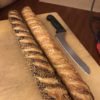OK, pop quiz: What do “The Brothers Karamazov,” “Anna Karenina,” and “The Cherry Orchard” have in common? They all talk about Kvass. The authors were Russian and Kvass is a popular drink there and all around Eastern Europe. But, until recently, there wasn’t much of it available in the States.
So what is kvass? Well, it’s a lacto-fermented beverage made from stale rye bread. To find out more, Brendan spoke with Raphael Lyon, who makes this at a place called Enlightenment Wines in Brooklyn.
Brendan got the scoop on their process for making the drink, what their Russian customers think of their take on it, and more. (Bonus: there’s a cocktail recipe that utilizes the drink. See video below.)
How their bread-based kvass measures up

Raphael Lyon: Traditionally a kvass would be something that you’d make from stale bread. And also, because it’s a folk drink, there’s a huge variability for it. So, there’s nothing particularly authentic about any version of it. Some people would put fruit in it, some people would put things like coriander. We don’t do that here, we just work with the bread.
So, this is a pellicle, it’s basically a mass of lactobacillus. It’s the same organism that would be making yogurt. It’s a souring organism that takes sugars and turns them into acids. It’s actually incredibly stable. So, this isn’t refrigerated. I could probably leave it here for a year and you would be fine.
Brendan Francis Newnam: So, this is kind of the perfect drink if you’re poor and don’t have refrigeration.
Raphael Lyon: Yeah, absolutely. And keep in mind that water wasn’t super-healthy back then, so this is another way to clean your water. And people would drink a lot of this. It’s estimated that people would drink a liter, so this means they’re drinking it with every meal.
Kvass taste test

Raphael Lyon: It’s not really like beer at all. It’s kind of like a tonic or a refreshing drink.
Brendan Francis Newnam: Wow, it tastes… different than I expected. There is a mild taste to it [like] Kombucha, but then there’s like a light sweetness to it, which I’m guessing is the honey.
Raphael Lyon: Don’t forget to smell it because one of the nice things about letting it sit for a month is that it develops these nice floral aromas.
Brendan Francis Newnam: What kind of smells are you getting
Raphael Lyon: …Well, there’s a little coriander in there, there’s a little bit of, like, malt.
Brendan Francis Newnam: Is there alcohol in here?
Raphael Lyon: There is the amount of alcohol that you’d find like in kombucha. So, very small amount. We have a lot of people here that don’t drink, but aren’t allergic to alcohol who will drink this, but you’re gonna have a hard time getting drunk on it.
On what his Russian customers think of his take on kvass

Raphael Lyon: They like it, but there’s a lot of layers of culture going on there because this thing happened in the Soviet Union when everything was industrialized. And one of the things they did was they wanted to have like a national drink that could compete with Coca-Cola, so they took kvass in name and basically produced this industrialized version, which is still like malt-based. But, if you tasted it, it basically tastes like a malt soda. It doesn’t really have a lot to do with this.
Bonus cocktail: “Pain the in Kvass”
[This interview has been edited and condensed.]


